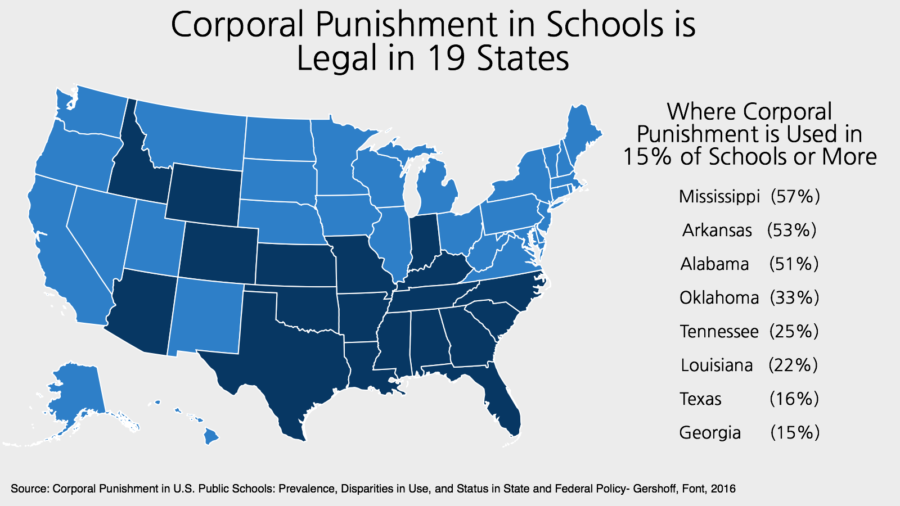Corporal Punishment
June 12, 2019
Here on the West Coast, many people take the privileges that we’re lucky to have for granted. Physical abuse is looked down upon and has been recognized as unhealthy and dangerous by many psychological studies, which is why corporal punishment is banned in the United States’ military training centres and can no longer be carried out as a sentence for a crime. It is prohibited at Head Start programs and in most juvenile detention facilities too. Yet, in our country, 19 states still allow corporal punishment, and actively use it in their schools.
“The recidivist male delinquent who has never been exposed to the belt, extension cord or fist at some time in his life is virtually non-existent. As the severity of corporal punishment in the delinquent’s developmental history increases, so does the probability that he will engage in a violent act,” said psychologist Doctor Ralph Welsh.
Around the world, 53 countries have banned physical punishment of children in all settings, including the home. The legal bans typically have been used as public education tools, rather than attempts to criminalise behaviour by parents who spank their children. With all of the evidence that has been provided by studies and psychological evaluations, it seems as though corporal punishment should have been extinguished entirely in the United States years ago.
According to the Education Department’s office for civil rights, more than 106,000 children were physically punished at public schools during the 2013-14 school year, which is nearly 95 times the amount of students that attended Laguna Beach High School during the 2016-2017 school year (1,116). An 11th grader from Wichita Falls, Texas was sent to the assistant principal and given three swift swats to the backside with a paddle. His mother later explained that the blows were so severe that they caused deep bruises and the boy wound up in the hospital. In places like this, discipline has been inflicted upon students to scare them into conformation rather than encourage reformation. I think it’s important to recognise that this is an issue, especially for those of us who live in a place like California, where corporal punishment has been banned in schools since 1986.
California Penal Code 273d(a) states that “Any person who willfully inflicts upon a child any cruel or inhuman corporal punishment or an injury resulting in a traumatic condition is guilty of a felony and shall be punished by imprisonment pursuant to subdivision (h) of Section 1170 for two, four, or six years”
Research has shown 15 significant trends associated with physical punishment:
-
Increased antisocial behaviour and delinquency as a child and as a young adult
-
Greater approval of other forms of violence, such as the belief that torture is sometimes justified to obtain information critical for national defence, or that there are occasions when it is justified to slap a wife or husband
-
Greater impulsiveness and less self-control
-
Poorer parent-child relationships
-
Riskier sexual behaviour as a teenager
-
Greater juvenile delinquency
-
More crime perpetrated as an adult
-
Poorer national average mental ability
-
Lower probability of graduating from college
-
Higher likelihood of depression
-
More violence against marital, cohabitating, and dating partners
-
More violence against non-family members
-
More physical abuse of children
-
More drug abuse
-
More sexual coercion and physically-forced sex







